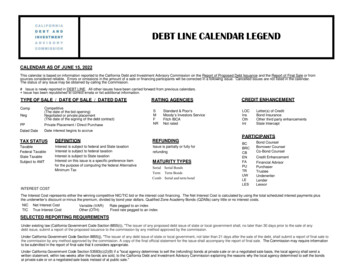
Transcription
CDIAC provides information, education and technical assistance on publicdebt and investments to local public agencies and other public financeprofessionals.1
The California Debt and Investment Advisory CommissionTechnical Webinar Series0Swaps Math:What Are Your Swaps Worth?Housekeeping Feedback Button Questions and Answers Polling Questions Certificate of Participation2
The California Debt and Investment Advisory CommissionTechnical Webinar Series0Swaps Math:What Are Your Swaps Worth? Introduction of SpeakersEric ChuManaging Director, BLX GroupNathanial SingerManaging Director, Swaps Financial Group3
The California Debt and Investment Advisory CommissionTechnical Webinar Series0Eric ChuManaging Director, BLX Group Over 19 years of experience in Public Finance Has extensive experience in all facets of implementing swap transactions lead author of the BLX 6roups booklet, Interest Rate SwapsNathanial SingerPartner, Swap Financial Group Over 24 years of experience in Municipal Finance Extensive experience in the design and implementation of innovative financial products .4 frequent speaker on topics relating to both the municipal & derivatives markets4
California Debt and Investment Advisory CommissionpresentsSwap Math: What Are Your Swaps Worth?November 30, 2011Nat SingerManaging DirectorSwap Financial Group LLC(973) 460-7900nsinger@swapfinancial.comEric H. ChuManaging DirectorBLX group LLC(213) 612-2136echu@blxgroup.comp. 5
CDIAC Swap Math: What Are Your Swaps Worth? November 2011OverviewInterest rate swaps are financial tools used by many local governmentagencies to manage interest rate risk. The swap market at times providesissuers the opportunity to lower their cost of financing versus traditionalalternatives in the bond market. Swaps remain an important tool in managingan issuer's debt service obligations and exposure to interest rate risk. Formany, swap pricing is often viewed as a "black box". This webinar is intendedto provide an understanding of swap math and includes: Information on the swap marketValuation methodologiesSwap dealer's pricing conventionsFormulas and examples of pricingReview of variables affecting market pricesp. 6
CDIAC Swap Math: What Are Your Swaps Worth? November 2011Part I: Before we get started .why look at swaps at all? Issuer has two general choices when selling fixed rate debt Option A: Sell traditional fixed rate bonds Option B: Sell variable rate bonds and swap to a fixed rate Why is there a difference in fixed rates under options A and B? Structural imbalance in the tax-exempt market (the neighborhood theory) Supply Side – Tax-exempt issuers are financing long lived assets (tollroads, office buildings, power plants, stadiums, etc.). The liabilitystructure matches the average lives (i.e. 30 to 40 year amortization).Demand Side – The largest buyers of long term fixed income products(pension funds and foreign sovereigns) don’t buy tax-exempt bonds.“Mom and Pop” retail focus on short maturities.p. 7
CDIAC Swap Math: What Are Your Swaps Worth? November 2011Part I: Before we get started .why look at swaps at all?Typical tax-exempt amortizationp. 8
CDIAC Swap Math: What Are Your Swaps Worth? November 2011Part I: Before we get started .why look at swaps at all? Result Lots of long term supply and limited long term demand Limited short term supply and lots of short term demand. Impact on Tax-Exempt Yield Curve: STEEP! The tax-exempt yield curve has NEVER inverted and is consistentlysteeper than the taxable yield curve. Short end of the tax-exempt yield curve is priced efficiently relative tothe taxable yield curve and the long end of the tax-exempt yield curve ispriced inefficiently when compared on a pre-tax equivalent basis.p. 9
CDIAC Swap Math: What Are Your Swaps Worth? November 2011Part I: Before we get started .why look at swaps at all?The Slope of the Municipal Yield Curve is Steeper than theTaxable Yield Curve5.0 0 0 , - - - - - - - - - - - - - - - - - - - - - - - - - - - - - -4.500L--------- T a bl eC u Ne ::::::::: Actual Muni Yield Curve"'03.500 -t------r------- ----------------t-Q) -3.000- -- ----------: ------- ::;;;;;;::::;; ;;;;;;;;;o::o-- ---o "!!!!!!!"' "" Tax·Efficient Muni Curve(65%of Taxable)2.5oJO-1-- - - --,JC-.,C.- - - - - - - - - - - - - - - - - - - ---1--1234567891011121314 151617Maturity (years)p. 101819202122232 1 252627282930
CDIAC Swap Math: What Are Your Swaps Worth? November 2011Part I: Before we get started .why look at swaps at all? Short Efficiency and Long Inefficiency results in swap opportunity How do tax-exempt issuers capture the benefits associated with a swapbased structure? Issue efficiently priced variable rate bonds Enter into fixed payer swapsp. 11
Why swap?Fixed Rate BondSynthetic Fixed Rate3.67%IssuerDealerIssuerFloating 4.50% FloatingBondHolderBondHolderp. 12
CDIAC Swap Math: What Are Your Swaps Worth? November 2011Part II: Where does the taxable swap curve come from? Broker/Dealers provide quotes, which are published real time through services such asBloomberg.Bid Ask Quotations are for vanilla transactions (fully collateralized, standardized ISDAs).Swap Rate Quotes: Pay fixed Receive floating 3 month LIBORp. 13
CDIAC Swap Math: What Are Your Swaps Worth? November 2011Part II: Where does the taxable swap curve come from?Complete LIBOR swap curve is derived from: LIBOR Fixings: Inter-bank lending rates up to 3 months Eurodollar futures: greater than 3 months and up to 3 years Quoted Swap rates: greater than 3 years Both new and existing swaps are priced and valued from the curve. Curve is constructed as 0% coupon, or ‘spot’ rates. Why? Individual cash flows can be discounted Forward rates can be extrapolated, or ‘bootstrapped’ p. 14
CDIAC Swap Math: What Are Your Swaps Worth? November 2011Part III: Pricing and Valuing SwapsSwaps are valued using the present value (PV) cash flow method Value of a swap as of any date is equal to the: PV of the Future Fixed Cash Flows minus, PV of the Future Floating Cash Flows Each (fixed or floating) cash flow is PV’d using discount factor derived fromthe 0% coupon or spot rate matching the date of the cash flow. I know the future fixed payments, but floating? Future floating payments are also determined using the spot rates: Future, or “forward” rates are mathematically ‘bootstrapped’ Example: If one-month rates today are 0.26%, and two-month ratestoday are 0.37%.what are one-month rates one-month forward? Solving for x, tells us that the forward rate is .48%This process is repeated to compute all forward rates under a swapp. 15
CDIAC Swap Math: What Are Your Swaps Worth? November 2011Part III: Pricing and Valuing Swaps Example: 10,000,000 10 Year Swap 2.173% Fixed Rate vs. 3M LIBOR Forward rates and net swap cash flows are highlighted belowp. 16
CDIAC Swap Math: What Are Your Swaps Worth? November 2011Part III: Pricing and Valuing Swaps On-Market vs. Off-Market Swap New swaps are generally ‘on-market’, where you solve for the fixed rate in order tomake the value (the MTM) of the swap equal to 0 (ignoring the dealer’s ‘spread’) 10 Yr. Swap example has a fixed rate of 2.173%, which causes the PV of the fixedleg to equal the floating leg, hence is the on-market rate. Off-market swaps are new swaps that have up-front payments. Also, as of anydate, virtually every swap entered into previously is now ‘off-market’.Historical Rates: LIBOR swap curve today, 3 yrs. ago, and 6 yrs. ago p. 17
CDIAC Swap Math: What Are Your Swaps Worth? November 2011Part III: Pricing and Valuing Swaps How do interest rate changes affect my swap? Assume pay 2.173% fixed rate, receive 3M LIBOR floating rate swapOn valuation date, assume our previously highlighted historical yield curvesCurveDateChange in RatesNov 2011NoneNov 2008Nov 2005 Change inValueOn-MarketRateOff-MarketRate PortionNone2.1730.000Higher 1,388,0003.8181.645Higher, Flatter 2,229,0005.0102.837Conversely, if rates were lower on any of these dates, the change in value wouldbe negative. (No examples since rates never been lower than today!)p. 18
CDIAC Swap Math: What Are Your Swaps Worth? November 2011Part III: Pricing and Valuing SwapsMTMOff-MarketRate (in bp)PV01p. 19andFixedRateOff-MarketRateOn-MarketRate
CDIAC Swap Math: What Are Your Swaps Worth? November 2011Part III: Pricing and Valuing Swaps Illustration of PV01 0%5002/12 5/12 8/12 11/12 2/13 5/13 8/13 11/13 2/14 5/14 8/14 11/14 2/15 5/15 8/15 11/15 2/16 5/16 8/16 11/16 2/17 5/17 8/17 11/17 2/18 5/18 8/18 11/18 2/19 5/19 8/19 11/19 2/20 5/20 8/20 11/20 2/21 5/21 8/21 11/21PV of 1bp CouponLIBOR Swap Curve Zero RatePV01 249.69 249.21 199.85 9,193.04p. 200.00%
CDIAC Swap Math: What Are Your Swaps Worth? November 2011Part III: Pricing and Valuing Swaps Estimating the Change in Value for Your Swaps From PV01 and DV01 PV01 PV of .01% coupon DV01 Change in value for a .01% parallel shift in yield curve.What’s the difference? For a vanilla swap, where the floating leg is 1M LIBOR or 3M LIBOR (not a % of1M or 3M), then PV01 and DV01 are in fact the same. Therefore, if you know the PV01, and the average life of the swap, then you canestimate the change value given a change in the LIBOR swap curve. In our example, if ‘rates are up today by 2bp’, then you could estimatethat the swap increased in value by 18,386 (2 X 9,193) However, if the swap floating leg is 67% (or other percentage) of 1M/3M LIBOR,then DV01 67% X PV01. If our example was a 67% LIBOR swap , then if rates up by 2bp,change in value equal to 12,318 (67% X 18,386). Note, you can ignore the floating leg margin (or spread) if one existsp. 21
CDIAC Swap Math: What Are Your Swaps Worth? November 2011Part III: Pricing and Valuing Swaps Practical Application of Pricing Tools Ask swap provider for the PV01. This is a noncontroversial figure- it's just math. Find swap rates at www.wsj.com or www.federalreserve.govKnow limitations of PV01 and estimating values and/or on-market ratesAverage life is reasonable but imperfect measurement of a swap's amortization.Standard quotes from subscription services (e.g., Bloomberg, Reuters, etc.) aswell as from public sources (e.g., WSJ, Fed) are semi-Annual, 30/360 fixed andquarterly, acU360 3M LIBOR floatingAny differences will cause the on-market rate of your swap to be different.For example, impact of changing from acU360 to acUact reduces the fixed rate by360about 1.3% (simply, 1), or about 4bp if the fixed rate were 3% otherwise365Compounding: The more frequent the payment, the lower the nominal fixed rate1M vs 3M LIBOR: Different pricing for 1M LIBOR.p. 22
CDIAC Swap Math: What Are Your Swaps Worth? November 2011Part IV: How does a dealer manage their swap position? Governmental issuers are ‘end users’ while broker/dealers and banks aregenerally and financial intermediaries As an end-user, the governmental is typically using the swap as a tool tohedge a bond or similar debt, or asset. A broker/dealer typically does not have a natural use for the swap andso will enter into an offsetting transaction (a “Matched Book”) Not interested in taking on interest rate risk Hedges on a portfolio basis, not a one to one basis. Stays in business by charging a spread on each swap, asmentioned earlierp. 23
A Matched Book4.00%3.98%Client ADealerp. 24Client B
How Does Market Volatility Affect a Portfolio? EKG of an ideal derivative portfolio EKG of a typical derivative portfoliop. 25
Value of a derivative contract/portfolio ƒ(underlying hedges)LIBORSwapsBMA/LIBORRatio SwapsBasis Swaps(81)(20)SwapSpreads(16)(15)CreditSpreadsLIBOR es(16)p. 26BMAVolatility(171)YieldCurve Interpolation
CDIAC Swap Math: What Are Your Swaps Worth? November 2011Part IV: How does a dealer manage their swap position?p. 27
CDIAC Swap Math: What Are Your Swaps Worth? November 2011Part IV: How does a dealer manage their swap position?p. 28
CDIAC Swap Math: What Are Your Swaps Worth? November 2011Part IV: How does a dealer manage their swap position?p. 29
CDIAC Swap Math: What Are Your Swaps Worth? November 2011Part IV: How does a dealer manage their swap position?p. 30
CDIAC Swap Math: What Are Your Swaps Worth? November 2011Part IV: How does a dealer manage their swap position?p. 31p. 31
Trade Example: Trading System Output Exposure to Parallel Shift of Underlying Variables 700,000 600,000 500,000 400,000 300,000 200,000 100,000 0Yield CurveBMA Ratiop. 32Volatility
Trade Example: Trading System Output after Hedging Exposure After Hedging 1 1 1 1 1 1 0 0 0 0 0DeltaBMA Ratiop. 33Vega
The California Debt and Investment Advisory CommissionTechnical Webinar Series0Thank YouforParticipatingFor more information about CDIAC's upcomingwebinars and seminars please visitwww.treasurer.ca.gov1cdiacor call (916) 653-3269To sign up for CDIAC’s seminar notification service visit: www.treasurer.ca.gov/cdiac andclick on “Sign Up to Receive Information on CDIAC Seminars and Publications”
alternatives in the bond market. Swaps remain an important tool in managing an issuer's debt service obligations and exposure to interest rate risk. For many, swap pricing is often viewed as a "black box". This webinar is intended to provide an understanding of swap math and includes: Information on the swap market Valuation methodologies










